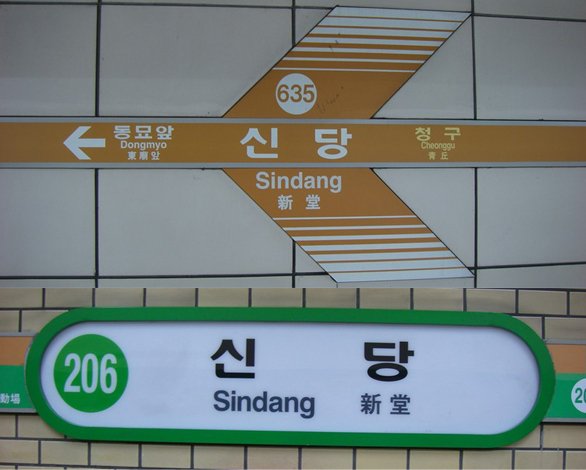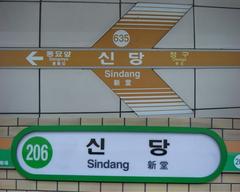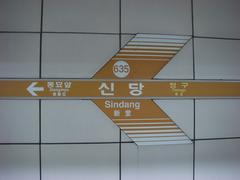
Sindang Station: Visiting Hours, Tickets, and Nearby Attractions in Seoul
Date: 14/06/2025
Introduction
Sindang Station, located in Seoul’s Jung-gu district, is more than a key transportation interchange—it is a vibrant cultural and culinary destination that encapsulates the city’s dynamic blend of tradition and innovation. From its notable past as a grain trade hub to its global reputation as the heart of Sindang-dong Tteokbokki Town, the neighborhood offers a unique window into Seoul’s evolving urban landscape. This guide offers a comprehensive look at Sindang Station’s history, culinary heritage, accessibility, visiting information, and the best nearby attractions for an immersive Seoul experience (Korea Herald; Visit Seoul; Seoul City).
Table of Contents
- Introduction
- Historical Background and Cultural Significance
- Culinary Heritage: Sindang-dong Tteokbokki Town
- Urban Renewal and the “Newtro” Movement
- Practical Visitor Information
- Frequently Asked Questions (FAQ)
- Summary & Recommendations
- References
Historical Background and Cultural Significance
Origins and Economic Role
Sindang-dong flourished in the early 20th century as Seoul’s central grain trade district, with nearly 800 shops handling over 80% of the city’s grain transactions during the 1920s–30s. The area’s economic vitality not only shaped local livelihoods but also influenced Korea’s industrial landscape—most notably, Hyundai Group founder Chung Ju-yung began his career here as a rice dealer (Korea Herald).
Transformation Over Time
By the 1980s, changes in consumption patterns and the advent of supermarkets led to the decline of the traditional grain market. Many original warehouses have since been creatively repurposed, reflecting a city-wide trend of adapting historical spaces for modern uses and preserving urban memory (Korea Herald).
Culinary Heritage: Sindang-dong Tteokbokki Town
The Birth of Tteokbokki Culture
Sindang-dong became synonymous with tteokbokki, Korea’s iconic spicy rice cake dish, thanks to Ma Bok-rim, who began selling it in the 1950s. Her innovation—combining rice cakes with gochujang (spicy chili paste)—sparked a culinary legacy. Over the decades, local vendors diversified recipes, introducing variations like cheese, seafood, and instant noodles, making the area a pilgrimage site for food lovers (Visit Seoul).
Social and Cultural Impact
By the 1970s–80s, Tteokbokki Town had become a hotspot for Seoul’s youth, with eateries offering lively atmospheres and DJ music. Today, this legacy continues, attracting both nostalgic locals and new generations drawn by the “newtro” (new + retro) sensibility (Visit Korea).
Annual Tteokbokki Festival
Every autumn, Sindang-dong celebrates its culinary heritage with the Tteokbokki Festival, featuring cooking contests, street performances, and special menus, further solidifying its reputation as a living museum of Korean street food culture (Visit Seoul).
Urban Renewal and the “Newtro” Movement
Adaptive Reuse and Revitalization
The rebirth of Sindang’s historic commercial core has been driven by the “newtro” wave, which transforms old rice warehouses and grain shops into trendy cafes, bars, and creative studios. Venues like Seshimjung, a bakery café in a former grain storehouse, exemplify this blend of vintage charm and modern aesthetics (Korea Herald).
Street Culture and Nightlife
The area near Exit 12 is now known for its vibrant nightlife, street art, and influencer-frequented spots, including zodiac-themed bars and variety shops. This creative renaissance has brought renewed attention to Sindang as a hub for street culture and social gathering (Seoul City).
Practical Visitor Information
Visiting Hours & Ticketing
- Sindang Station: Open daily, trains operate from ~5:30 AM to midnight (Wikipedia).
- Entry: No special ticket for the station; use standard subway fare, best paid via T-money card.
- Tteokbokki Town Eateries: Most open from 10:00 AM to 10:00 PM; hours may vary by establishment.
Accessibility & Facilities
- Elevators, ramps, tactile paving, and accessible restrooms are available.
- Coin lockers for luggage, free Wi-Fi, and multilingual signage.
- Barrier-free transfers between lines 2 and 6.
Getting There & Station Exits
- Lines Served: Line 2 (Green) and Line 6 (Brown) (Klook).
- Exit 7: Direct access to Sindang-dong Tteokbokki Town.
- Exit 9: Chungmu Arts Hall.
- Other Exits: Seoul Central Market, local shops, and bus stops.
Nearby Attractions & Best Times to Visit
- Seoul Central Market: 5-minute walk; best for seafood, dried fish, and snacks.
- Dongdaemun Design Plaza (DDP): 1 subway stop away for art and design exhibitions (Dongdaemun Design Plaza).
- Cheonggyecheon Stream: Urban walking path 10 minutes on foot.
- Best Seasons: Spring (cherry blossoms) and autumn (Tteokbokki Festival, fall foliage) (Seoul Itinerary Guide).
Frequently Asked Questions (FAQ)
Q: What are Sindang Station’s operating hours?
A: Trains run from ~5:30 AM to midnight.
Q: How do I purchase subway tickets?
A: Via vending machines or by using a rechargeable T-money card.
Q: Is the station accessible for wheelchair users?
A: Yes; elevators, ramps, and tactile paving are provided.
Q: Where can I store my luggage?
A: Coin lockers are available in the station.
Q: What is the best exit for Tteokbokki Town?
A: Exit 7.
Q: Are guided tours available?
A: Local operators offer food and cultural walking tours in the area.
Summary & Recommendations
Sindang Station is a living crossroads of Seoul’s heritage and modern lifestyle. Its transformation from a grain trading powerhouse to a culinary and cultural hotspot is reflected in its bustling tteokbokki alleys, revitalized markets, and fusion of old and new in architecture and street culture. With excellent subway access (Lines 2 & 6), barrier-free facilities, and proximity to top attractions like Seoul Central Market and Dongdaemun Design Plaza, Sindang Station is a must-visit for anyone seeking an authentic and accessible Seoul experience. For the best visit, plan around the Tteokbokki Festival in autumn, use a T-money card for transit, and don’t miss the local markets for souvenirs and street food (Korea Herald; Visit Seoul; Seoul City).
References
- Korea Herald: Sindang Station – Visiting Hours, History, and Seoul’s Iconic Tteokbokki Town
- Klook: Sindang Station Visiting Hours, Tickets, and Travel Guide
- Visit Seoul: Sindang-dong Tteokbokki Town
- Korea Travel Planning: Transportation, Accessibility, and Visitor Recommendations
- Wikipedia: Sindang Station
- Seoul City: Transformation of Sindang Station into a Hip Space for Street Culture
- Dongdaemun Design Plaza (DDP)
- Seoul Itinerary Guide
For real-time transit updates, guided tours, and insider tips, download the Audiala app and follow us on social media for the latest on Seoul’s cultural gems.














































































































































































































